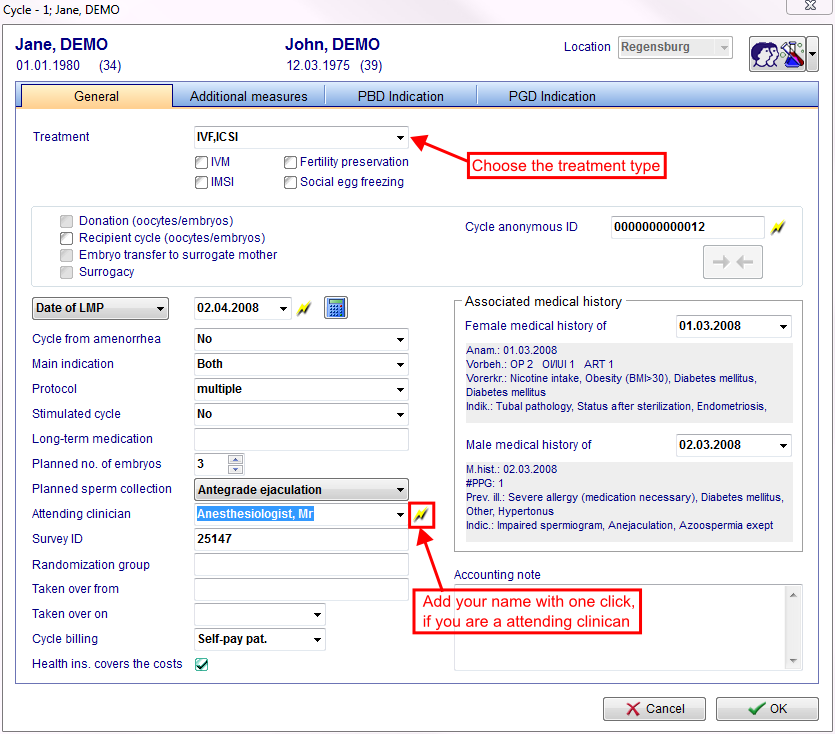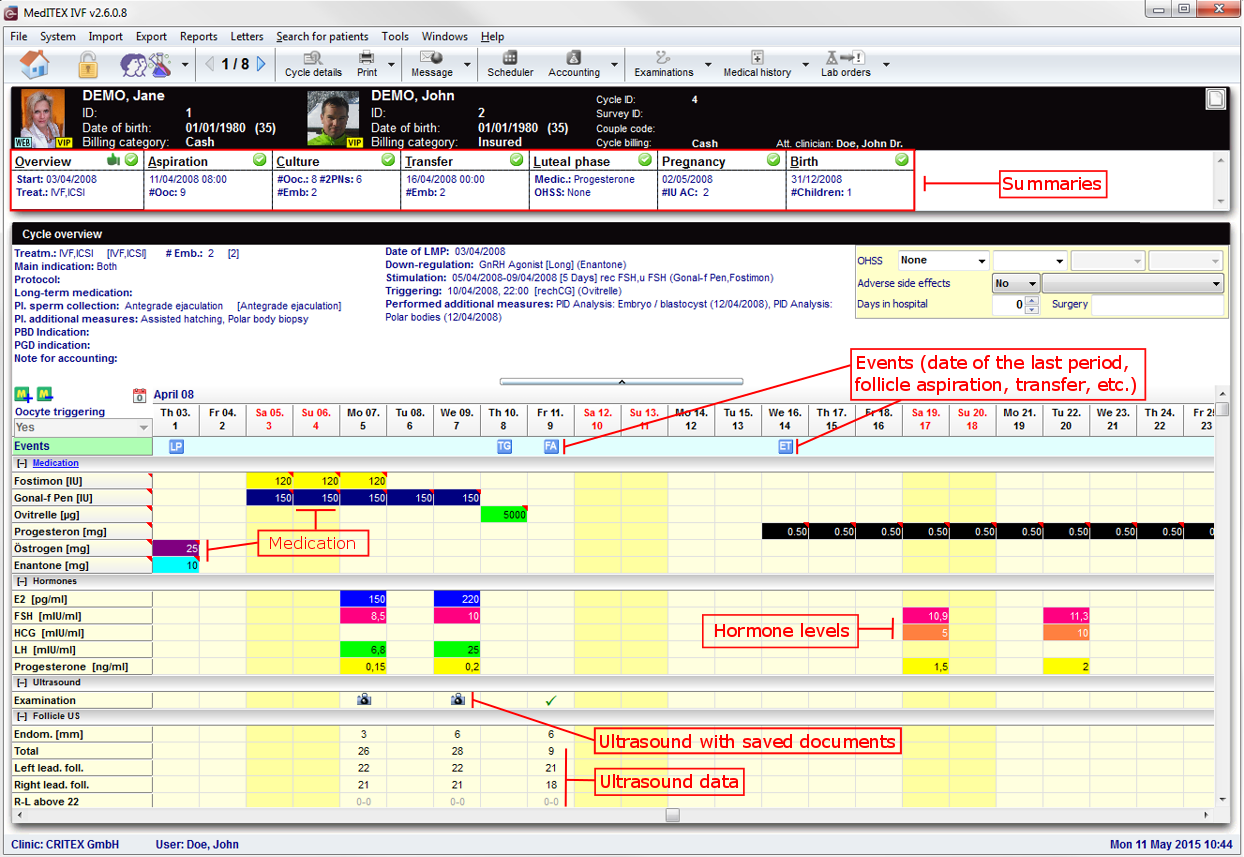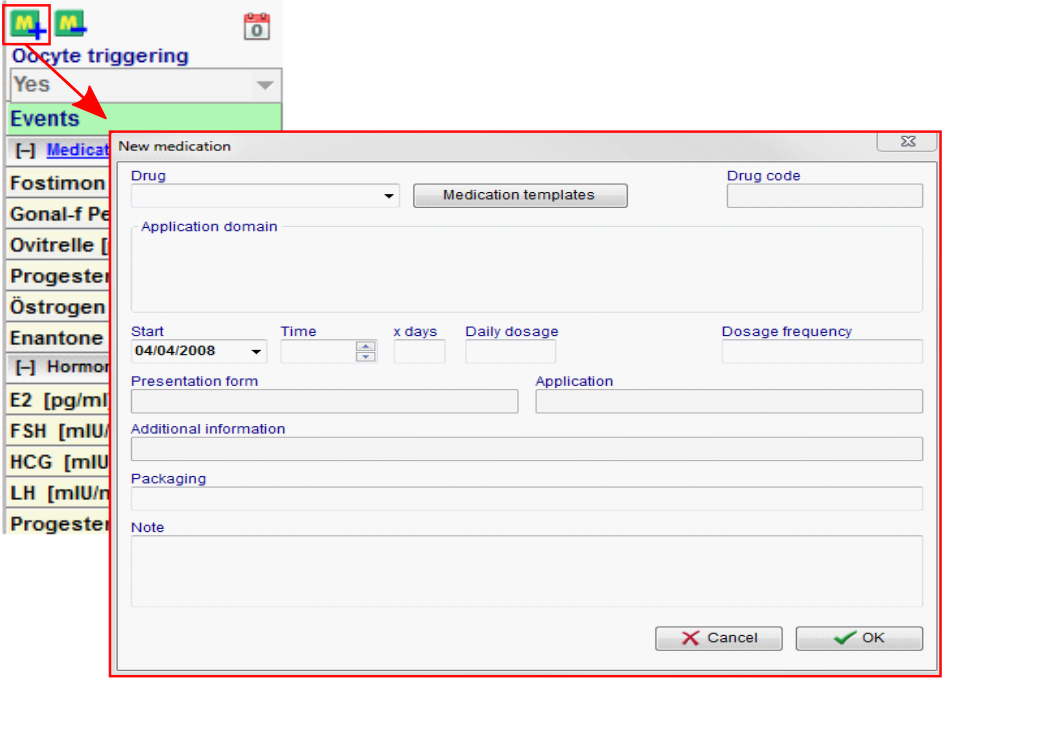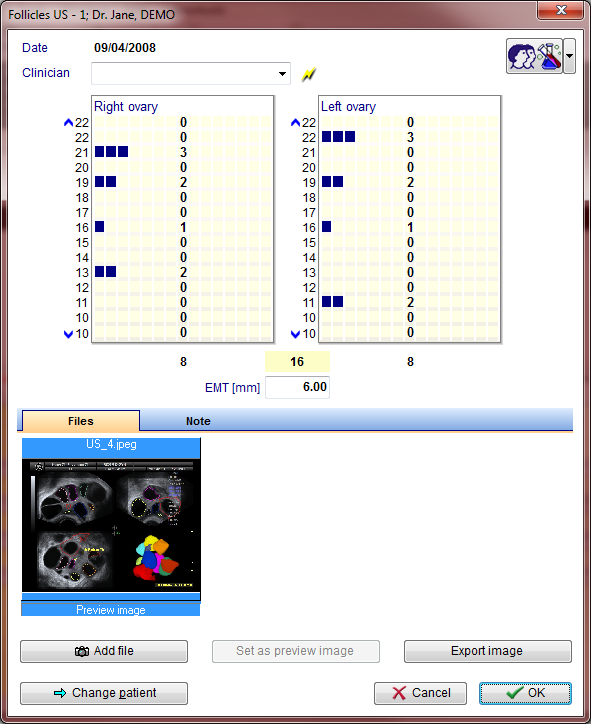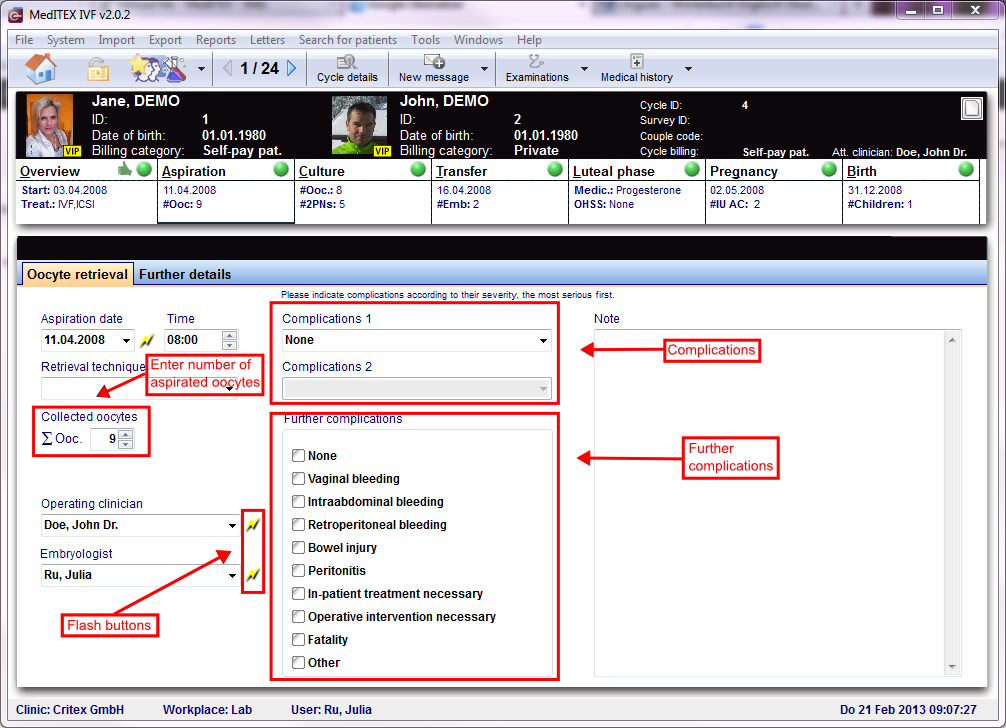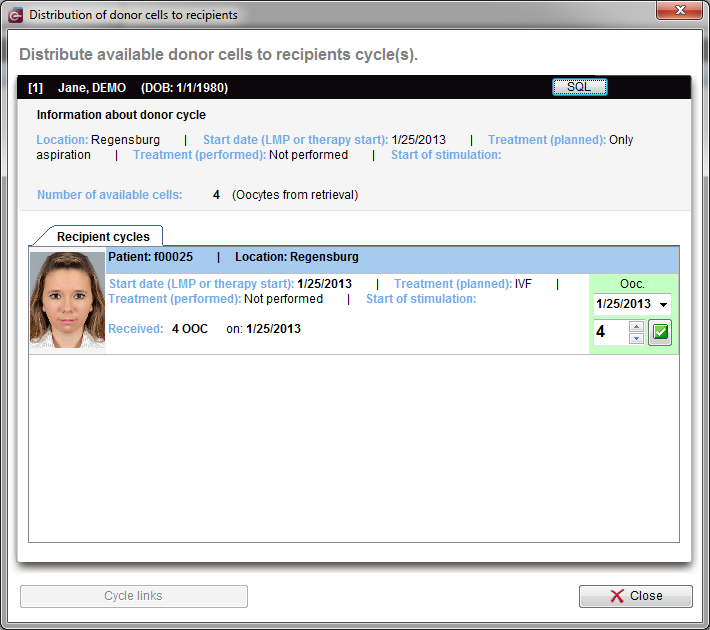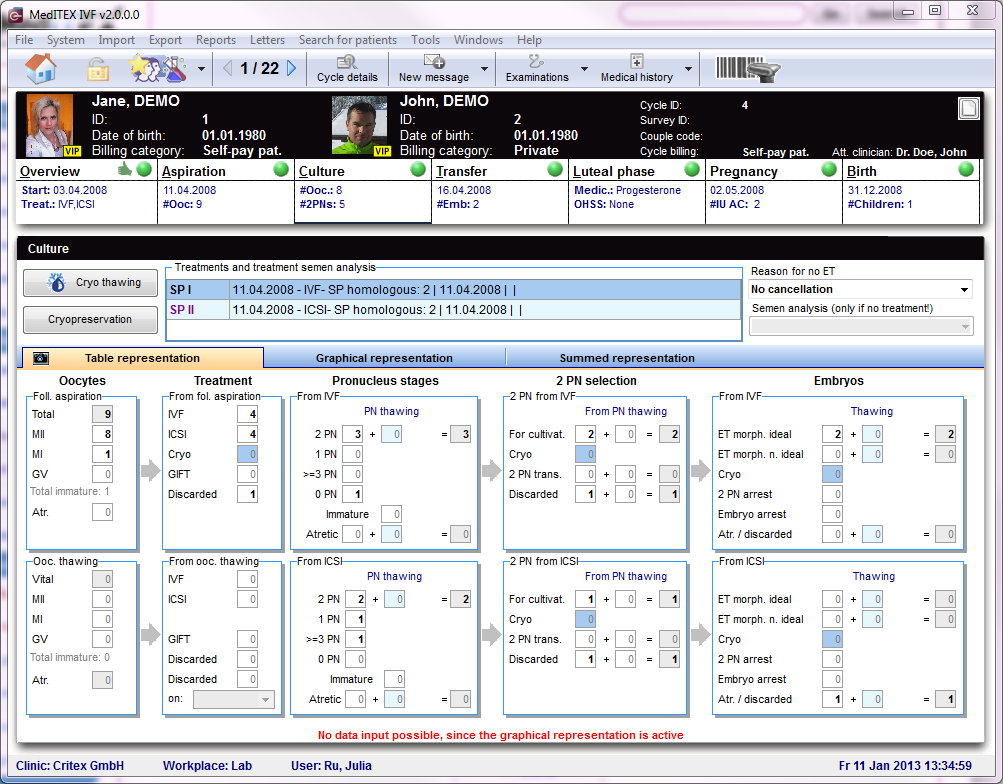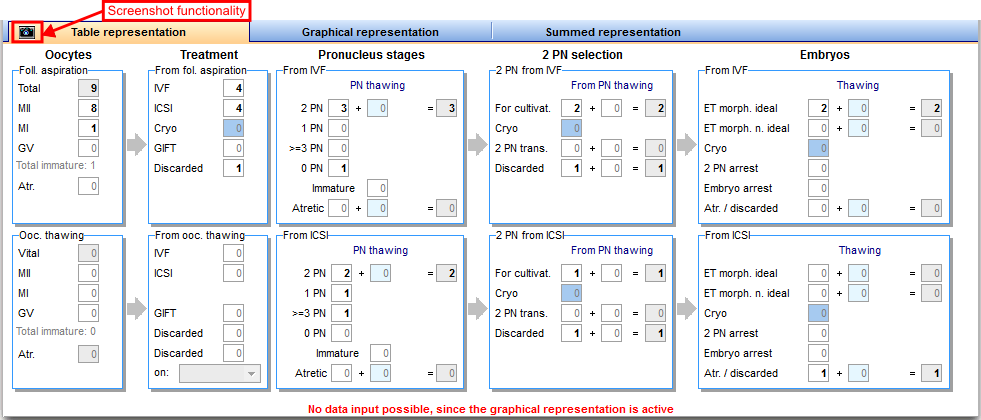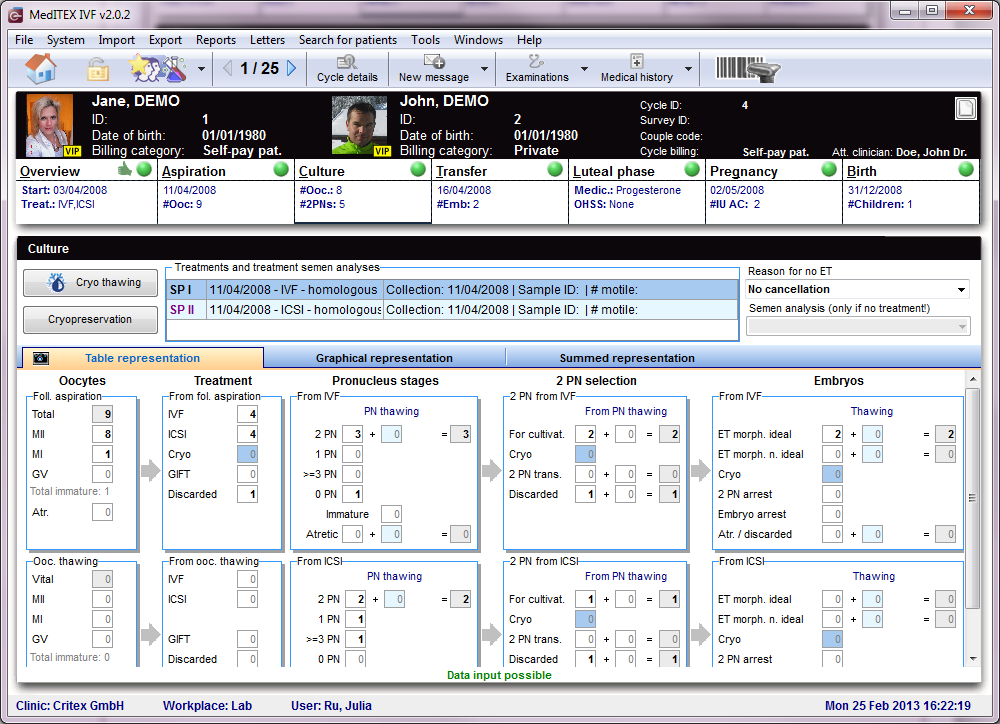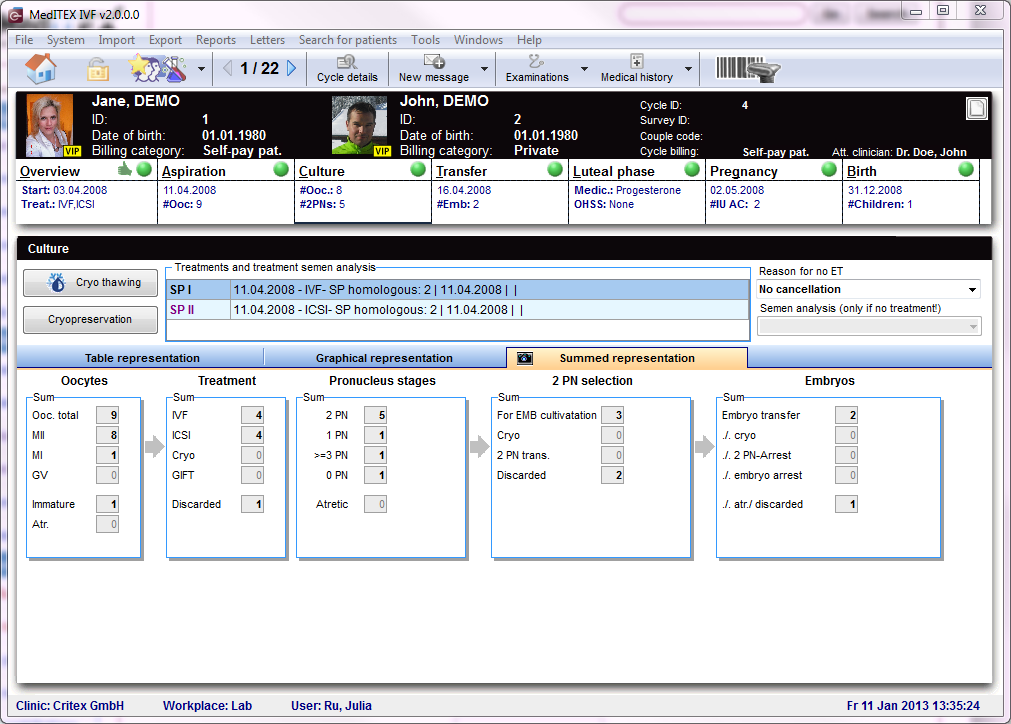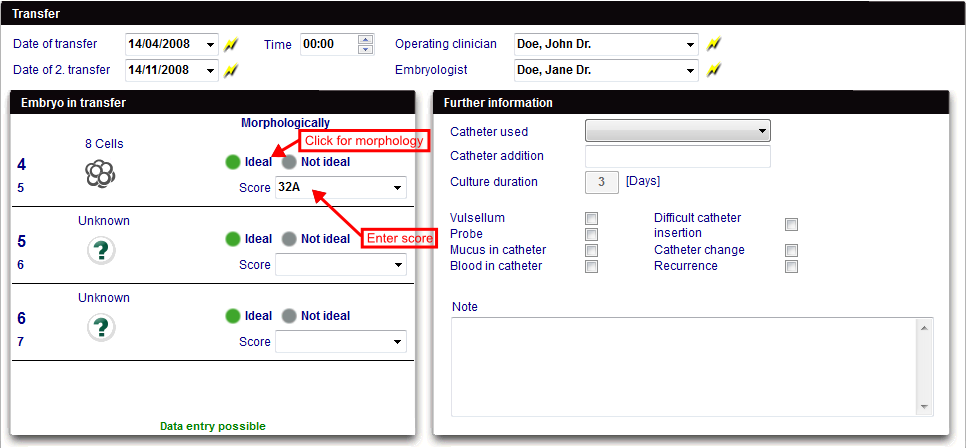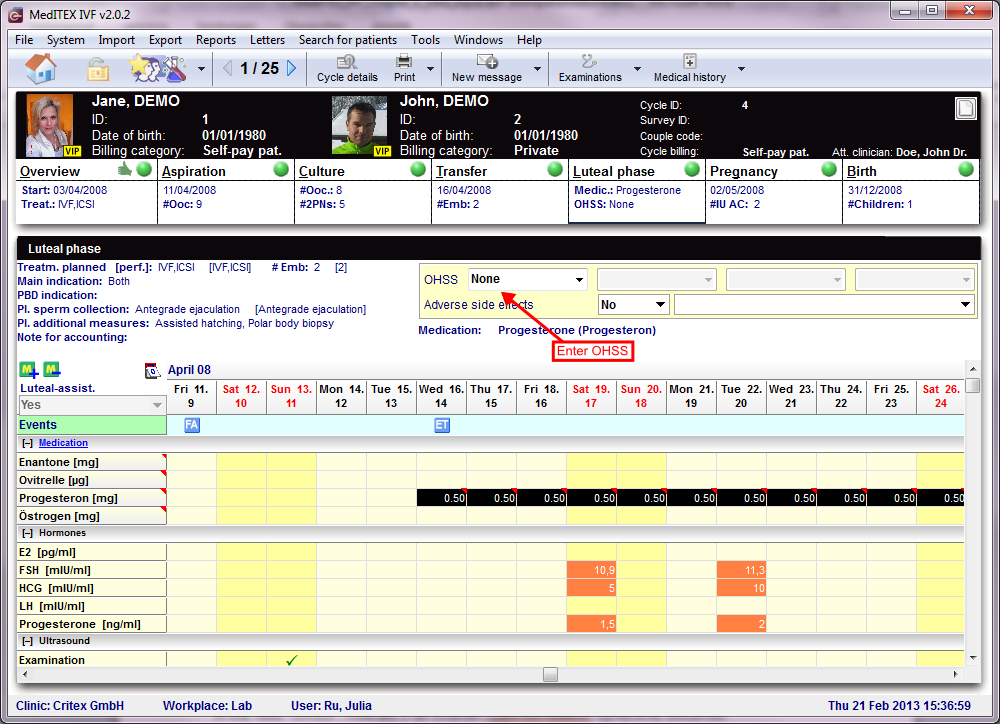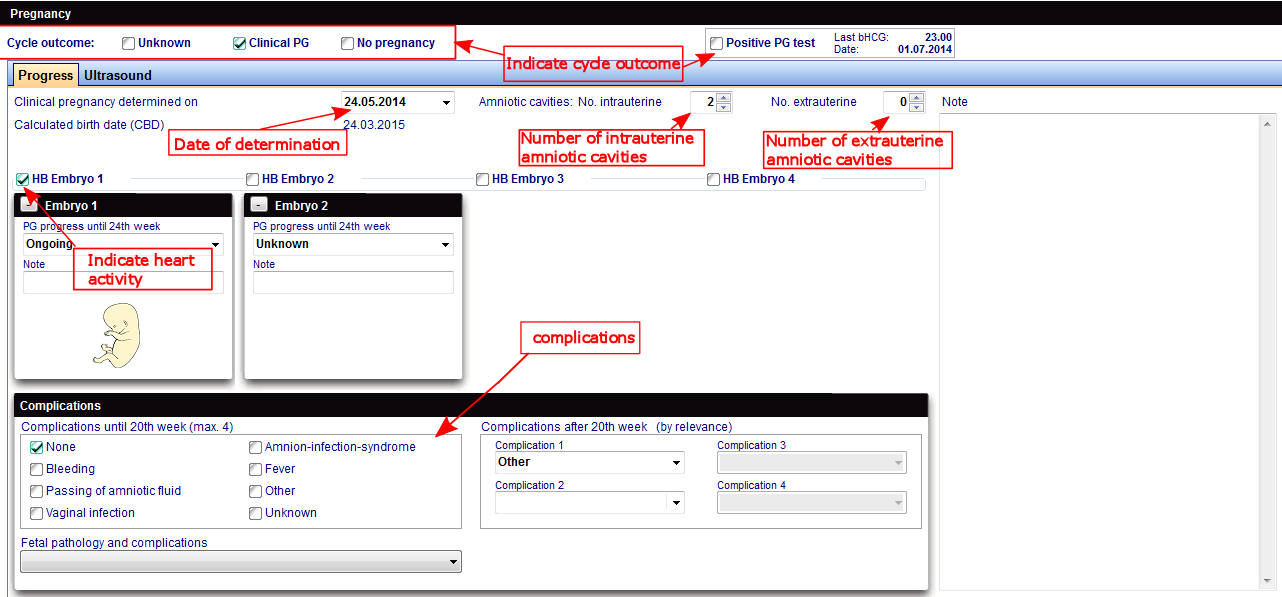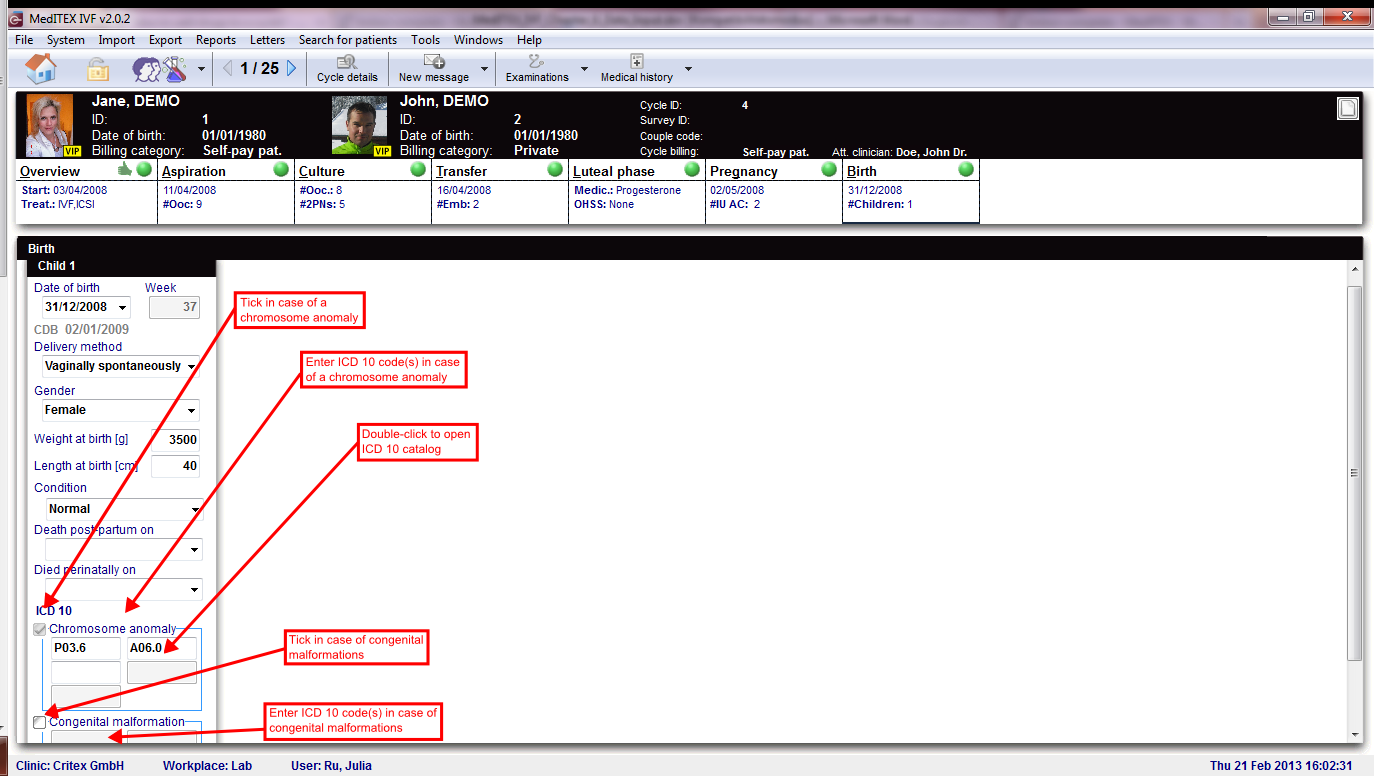Cycles
From MedITEX - Wiki
| Line 7: | Line 7: | ||
</tbody> | </tbody> | ||
</table> | </table> | ||
| − | |||
| − | |||
<p> </p> | <p> </p> | ||
<p>To add a <strong>new cycle</strong>, click on the <strong>Plus </strong>button at the bottom left corner of the screen. The following window will open:</p> | <p>To add a <strong>new cycle</strong>, click on the <strong>Plus </strong>button at the bottom left corner of the screen. The following window will open:</p> | ||
| − | |||
| − | |||
<table style="margin-left: auto; margin-right: auto;" border="0"> | <table style="margin-left: auto; margin-right: auto;" border="0"> | ||
<tbody> | <tbody> | ||
| Line 50: | Line 46: | ||
</table> | </table> | ||
<p> </p> | <p> </p> | ||
| − | <p>Once the window has refreshed, it will display the <strong>Overview </strong>tab of the cycle. These tabs, displayed below, work similar to a timeline. They are specially positioned to recreate the normal workflow of cycles. These tabs, also referred to as summaries, will always stay on the top part of the window and they will change according to the cycle created.</p> | + | <p>Once the window has refreshed, it will display the <strong>Overview </strong>tab of the cycle. These tabs, displayed below, work similar to a timeline. They are specially positioned to recreate the normal workflow of cycles. These tabs, also referred to as summaries, will always stay on the top part of the window and they will change according to the cycle created.</p> |
<table style="margin-left: auto; margin-right: auto;" border="0"> | <table style="margin-left: auto; margin-right: auto;" border="0"> | ||
<tbody> | <tbody> | ||
| Line 81: | Line 77: | ||
<p> </p> | <p> </p> | ||
<h3>Buttons</h3> | <h3>Buttons</h3> | ||
| + | <p>The top of the screen will always contain a series of buttons. Some other buttons will be displayed depending on the selected tab and they will be described separetly in each tab.</p> | ||
<p>Buttons with a blue dotted frame have special functionalities. Click on them to have further information.</p> | <p>Buttons with a blue dotted frame have special functionalities. Click on them to have further information.</p> | ||
<table style="margin-left: auto; margin-right: auto;" border="0"> | <table style="margin-left: auto; margin-right: auto;" border="0"> | ||
| Line 135: | Line 132: | ||
<p>[[Image:CycleOv.png|none|740px|thumb|left|link=http://wiki.meditex-software.com/images/CycleOv.png| ]]</p> | <p>[[Image:CycleOv.png|none|740px|thumb|left|link=http://wiki.meditex-software.com/images/CycleOv.png| ]]</p> | ||
</td> | </td> | ||
| + | </tr> | ||
| + | </tbody> | ||
| + | </table> | ||
| + | <p> </p> | ||
| + | <p>The top part of the <strong>Cycle overview</strong> displays important information about this cycle, such as: type of treatment, number of embryos planned, etc. The left section displays information containned in the <strong>Cycle details</strong> and if you click on this section, <strong>Cycle details </strong>will open. The right section contains information that is retrieved from the cycle in course, for example, it displays the date o the last menstrual period, the date of the triggering and the medication used, etc.</p> | ||
| + | <table style="margin-left: auto; margin-right: auto;" border="0" width="86" height="44"> | ||
| + | <tbody> | ||
| + | <tr> | ||
| + | <td><img src="/images/CycleOverviewSummary.png" alt="" width="757" height="137" /></td> | ||
| + | </tr> | ||
| + | <tr> | ||
| + | <td><img src="/images/hint48.png" alt="" width="48" height="48" /> One important information about this section is the use of brackets ([]). Information displayed inside brackets represent what procedure took place. For example, from the image above, the treatment that was planned when creating this cycle was <strong>IVF,ICSI</strong> and, right next to it, the brackets information shows that what was planned actually happened. Another example is the <strong>Pl. sperm collection</strong> that initially, was <strong>Antegrade ejaculation</strong> but in fact, <strong>Electrostimulation</strong> was used.</td> | ||
</tr> | </tr> | ||
</tbody> | </tbody> | ||
| Line 146: | Line 155: | ||
<td> | <td> | ||
<ul> | <ul> | ||
| − | <li><strong>Events: </strong>Shows important events such as the first | + | <li><strong>Events: </strong>Shows important events such as the first day of the last menstrual period, follicle aspiration, transfer, or clinical pregnancy. MedITEX IVF will generate this information automatically according to user’s entries in the corresponding therapy areas.</li> |
</ul> | </ul> | ||
<ul> | <ul> | ||
<li><strong>Medication:</strong> A dynamic area where you can create an individual line for every drug used during the treatment</li> | <li><strong>Medication:</strong> A dynamic area where you can create an individual line for every drug used during the treatment</li> | ||
| − | |||
| − | |||
</ul> | </ul> | ||
<ul> | <ul> | ||
| Line 157: | Line 164: | ||
</ul> | </ul> | ||
<ul> | <ul> | ||
| − | + | <li><strong>Follicle US:</strong> In this area you can document folliculometry and other ultra sound data including photographs of ovaries. The pictures and follicle measurements produced by special ultrasound devices can be automatically imported to MedITEX IVF via the DICOM interface, if the DICOM module has been purchased.</li> | |
| − | + | ||
| − | <li><strong>Follicle US:</strong> In this area you can document | + | |
| − | + | ||
| − | + | ||
</ul> | </ul> | ||
<br /></td> | <br /></td> | ||
| Line 184: | Line 187: | ||
</tbody> | </tbody> | ||
</table> | </table> | ||
| − | <p>MedITEX IVF provides you with a list of all main drugs that are used in reproductive-medical treatments. Additional drugs can be individually defined in the <a href="/index.php?title=MedITEX_IVF_Settings#Drugs">system settings</a>.</p> | + | <p>MedITEX IVF provides you with a list of all main drugs that are used in reproductive-medical treatments. Additional drugs can be individually defined in the <a href="/index.php?title=MedITEX_IVF_Settings#Drugs">system settings</a>.</p> |
<table border="0"> | <table border="0"> | ||
<tbody> | <tbody> | ||
| Line 195: | Line 198: | ||
<ul> | <ul> | ||
<li>In the new window, choose the drug, dosage and the application start and time. You can add additional drugs in the <a href="/index.php?title=MedITEX_IVF_Settings#Drugs">system settings</a>. | <li>In the new window, choose the drug, dosage and the application start and time. You can add additional drugs in the <a href="/index.php?title=MedITEX_IVF_Settings#Drugs">system settings</a>. | ||
| − | <p><strong>Tip:</strong> Enter the first letter(s) of the drug in the field to find the drug you are looking for more quickly. Select the drug from the list and confirm by pressing <RETURN>.</p> | + | <p><strong>Tip:</strong> Enter the first letter(s) of the drug in the field to find the drug you are looking for more quickly. Select the drug from the list and confirm by pressing <RETURN>.</p> |
</li> | </li> | ||
</ul> | </ul> | ||
<ul> | <ul> | ||
| − | <li><strong>Convenient: </strong>By defining an application area, all drug-related data – including the therapy protocols – will be immediately ready as you select a drug.</li> | + | <li><strong>Convenient: </strong>By defining an application area, all drug-related data – including the therapy protocols – will be immediately ready as you select a drug.</li> |
<li>You can <strong>lock</strong> single mediactions with a <strong>double click</strong> (or right click) on it. Locked medications has a grey corner. <img src="/images/GreyConrner.png" alt="" width="51" height="17" /></li> | <li>You can <strong>lock</strong> single mediactions with a <strong>double click</strong> (or right click) on it. Locked medications has a grey corner. <img src="/images/GreyConrner.png" alt="" width="51" height="17" /></li> | ||
| − | |||
| − | |||
</ul> | </ul> | ||
</td> | </td> | ||
| Line 256: | Line 257: | ||
<h2>Culture</h2> | <h2>Culture</h2> | ||
<p><strong>Precise documentation of every single oocyte.</strong></p> | <p><strong>Precise documentation of every single oocyte.</strong></p> | ||
| − | <p>Every egg cell is <strong>unique</strong>.<strong> Several methods</strong> have been developed to evaluate the development potential on cell and cleavage level. Cells are <strong>extracted</strong>, <strong>undergo a treatment</strong>, are <strong>frozen </strong>if necessary, <strong>transported</strong>, <strong> stored</strong>, <strong>thawed</strong>, <strong>cultivated again</strong> and <strong>transferred</strong>. Enough reasons to create documentation on cell level. The EU Directive "Cells and Tissue" also requires documentation on identifiability and traceability of each oocyte.</p> | + | <p>Every egg cell is <strong>unique</strong>.<strong> Several methods</strong> have been developed to evaluate the development potential on cell and cleavage level. Cells are <strong>extracted</strong>, <strong>undergo a treatment</strong>, are <strong>frozen </strong>if necessary, <strong>transported</strong>, <strong> stored</strong>, <strong>thawed</strong>, <strong>cultivated again</strong> and <strong>transferred</strong>. Enough reasons to create documentation on cell level. The EU Directive "Cells and Tissue" also requires documentation on identifiability and traceability of each oocyte.</p> |
<p>MedITEX IVF allows <strong>detailed documentation</strong> of <strong>all development stages</strong> and <strong>manipulations</strong> of each egg cell – <strong>exact to the day</strong>, including <strong>photos</strong>, <strong> scores</strong>, <strong>comments</strong>, <strong>performed analysis</strong> etc.</p> | <p>MedITEX IVF allows <strong>detailed documentation</strong> of <strong>all development stages</strong> and <strong>manipulations</strong> of each egg cell – <strong>exact to the day</strong>, including <strong>photos</strong>, <strong> scores</strong>, <strong>comments</strong>, <strong>performed analysis</strong> etc.</p> | ||
| − | <p>MedITEX IVF for the first time allows you to document complex | + | <p>MedITEX IVF for the first time allows you to document complex laboratory processes realistically, for example post maturing of individual egg cells, adding of thawed oocytes or performing fertilization on the following day.</p> |
<p>Every single obtained egg cell will be represented <strong>visually </strong>in a <strong> graphical </strong>overview. It allows entries for a <strong>maximum of ten cultivation days</strong>, although <strong>more then 5 to 6 days</strong> will most likely <strong>never </strong>be necessary. In the overview, <strong>development stages</strong> and <strong>manipulations </strong>such as <strong>insemination </strong>and <strong>injections</strong>, <strong>assisted hatching</strong>, <strong>polar body diagnosis</strong>, <strong> freezing </strong>and <strong>thawing processes</strong>, <strong>embryo transfer</strong> and <strong>more</strong>, can be assigned <strong>exact to the cell and day</strong>. All this can be done with a few mouse-clicks on the corresponding cells.</p> | <p>Every single obtained egg cell will be represented <strong>visually </strong>in a <strong> graphical </strong>overview. It allows entries for a <strong>maximum of ten cultivation days</strong>, although <strong>more then 5 to 6 days</strong> will most likely <strong>never </strong>be necessary. In the overview, <strong>development stages</strong> and <strong>manipulations </strong>such as <strong>insemination </strong>and <strong>injections</strong>, <strong>assisted hatching</strong>, <strong>polar body diagnosis</strong>, <strong> freezing </strong>and <strong>thawing processes</strong>, <strong>embryo transfer</strong> and <strong>more</strong>, can be assigned <strong>exact to the cell and day</strong>. All this can be done with a few mouse-clicks on the corresponding cells.</p> | ||
<p> </p> | <p> </p> | ||
| Line 269: | Line 270: | ||
</tbody> | </tbody> | ||
</table> | </table> | ||
| − | <p>Before entering data you should consider if you wish to put the focus of your documentation on summarized entries, or also on the individual egg cells. In the first case you should enter the data only in the table view, while in the second you should use the graphical representation. The graphical representation can also be used to "fine-tune” entries made in the tabular view.</p> | + | <p>Before entering data you should consider if you wish to put the focus of your documentation on summarized entries, or also on the individual egg cells. In the first case you should enter the data only in the table view, while in the second you should use the graphical representation. The graphical representation can also be used to "fine-tune” entries made in the tabular view.</p> |
| − | <p>The table and graphical representations are linked logically. Changes | + | <p>The table and graphical representations are linked logically. Changes made in one of the two views will also be represented in the other.</p> |
<p> </p> | <p> </p> | ||
<table style="margin-left: auto; margin-right: auto;" border="0"> | <table style="margin-left: auto; margin-right: auto;" border="0"> | ||
| Line 318: | Line 319: | ||
</tbody> | </tbody> | ||
</table> | </table> | ||
| − | <p>If that appears too complex, you can quickly insert data within a table overview. There you only need to enter summarized information about obtained, treated, fertilized and transferred egg cells.</p> | + | <p>If that appears too complex, you can quickly insert data within a table overview. There you only need to enter summarized information about obtained, treated, fertilized and transferred egg cells.</p> |
| − | <p>The table and graphical representations are linked logically. Changes made in one of the two views will also be represented in the other</p> | + | <p>The table and graphical representations are linked logically. Changes made in one of the two views will also be represented in the other</p> |
<p>The graphical representation can also be used to "fine-tune” entries made in the tabular view.</p> | <p>The graphical representation can also be used to "fine-tune” entries made in the tabular view.</p> | ||
<h3>Summed representation</h3> | <h3>Summed representation</h3> | ||
| Line 329: | Line 330: | ||
</tbody> | </tbody> | ||
</table> | </table> | ||
| − | <p>An additional summed representation provides a quick overview of the culture processes. The tabs allow you to change between the views with a single mouse click.</p> | + | <p>An additional summed representation provides a quick overview of the culture processes. The tabs allow you to change between the views with a single mouse click.</p> |
<p> </p> | <p> </p> | ||
<h2>Transfer</h2> | <h2>Transfer</h2> | ||
Revision as of 13:10, 7 February 2013
In the bottom part of the <a href="/index.php?title=MedITEX_IVF_main_page">starting window</a>, all cycles related to the selected patient are displayed.
To add a new cycle, click on the Plus button at the bottom left corner of the screen. The following window will open:
| <img src="/images/plus48.png" alt="" width="48" height="48" /> |
<a href="/index.php?title=Cycle_Details"><img style="border: 2px dotted blue;" src="/images/CycleDetails.png" alt="" /></a> Click on Cycle details to review information of the selected cycle. |
| <a href="/index.php?title=Create_a_new_entry_in_medical_history#Creating_a_female_Medical_History"><img style="border: 2px dotted blue;" src="/images/FemMedHis.png" alt="" /></a> <a href="/index.php?title=Create_a_new_entry_in_medical_history#Creating_a_male_Medical_History"><img style="border: 2px dotted blue;" src="/images/MaleMedHis.png" alt="" /></a>
Click on these buttons to open female or male medical history associated to the selected cycle. |
|
| <a href="/index.php?title=How_to_create_a_new_cycle%3F"><img src="/images/howto48.png" alt="" width="48" height="48" /></a> | <a href="/index.php?title=How_to_create_a_new_cycle%3F">Click here</a> to learn more about adding a new cycle. |
| <img src="/images/hint48.png" alt="" width="48" height="48" /> | To open a cycle, double-click its entry on the list. |
Once the window has refreshed, it will display the Overview tab of the cycle. These tabs, displayed below, work similar to a timeline. They are specially positioned to recreate the normal workflow of cycles. These tabs, also referred to as summaries, will always stay on the top part of the window and they will change according to the cycle created.
The summaries show the different treatment steps and have the following functions:
- They display the most important data.
- They show the status of the data and the their plausibility. These are indicated by round color symbols. If the symbol is red, put the mouse over it to know the reason.
- Click the different summaries to change between stages of the cycle.
| <img src="/images/hint48.png" alt="" width="48" height="48" /> |
|
Contents |
Buttons
The top of the screen will always contain a series of buttons. Some other buttons will be displayed depending on the selected tab and they will be described separetly in each tab.
Buttons with a blue dotted frame have special functionalities. Click on them to have further information.
| <a href="/index.php?title=MedITEX_IVF_main_page"><img style="display: block; margin-left: auto; margin-right: auto; border: 2px dotted blue;" src="/images/homeico.jpg" alt="" /></a> | Home: click on this button to go to the starting window. |
| <a href="/index.php?title=Locking_of_data"><img style="display: block; margin-left: auto; margin-right: auto; border: 2px dotted blue;" src="/images/LockIco.png" alt="" width="48" height="36" /></a> | Lock cycle: click on this button to complete lock this cycle from editing. |
| <a href="/index.php?title=Free_/_QM_fields"><img style="display: block; margin-left: auto; margin-right: auto; border: 2px dotted blue;" src="/images/QMIcon.png" alt="" width="88" height="36" /></a>
<a href="/index.php?title=Free_/_QM_fields"><img style="display: block; margin-left: auto; margin-right: auto; border: 2px dotted blue;" src="/images/QMIconContent.png" alt="" width="88" height="35" /></a> |
QM / free fields: click on this button to access the QM field section related to this area. Or click on the right arrow to block QM fields and to see the change log. <img src="/images/hint48.png" alt="" width="48" height="48" /> The star on the left corner of this icon indicates that information is included in the QM field. |
| <img style="display: block; margin-left: auto; margin-right: auto;" src="/images/LeftRightArrows.png" alt="" width="38" height="25" /> | Go one cycle back/forward. |
| <a href="/index.php?title=Cycle_Details"><img style="display: block; margin-left: auto; margin-right: auto; border: 2px dotted blue;" src="/images/CycleDetailsBigger.png" alt="" width="77" height="35" /></a> | Cycle details: opens a window containing the summary of the selected cycle. |
| <img style="display: block; margin-left: auto; margin-right: auto;" src="/images/PrintSmaller.png" alt="" width="53" height="35" /> | Print: click the arrow to choose one of the printing options. |
| <img style="display: block; margin-left: auto; margin-right: auto;" src="/images/NewMessage.png" alt="" /> | New message: click on this button to send a message to the patient. This message can be an SMS or a web portal message. |
| <a href="/index.php?title=Female_examinations"><img style="display: block; margin-left: auto; margin-right: auto; border: 2px dotted blue;" src="/images/ExamBigger.png" alt="" width="95" height="35" /></a> | Examinations: opens the last examamination. Click on the arrow to see all past evaluations. |
| <a href="/index.php?title=Create_a_new_entry_in_medical_history#Creating_a_Medical_History"><img style="display: block; margin-left: auto; margin-right: auto; border: 2px dotted blue;" src="/images/MedicalHistoryBigger.png" alt="" width="104" height="35" /></a> | Medical history: by default this button opens the female patient medical history. Click on the arrow to select the male. |
Overview
The top part of the Cycle overview displays important information about this cycle, such as: type of treatment, number of embryos planned, etc. The left section displays information containned in the Cycle details and if you click on this section, Cycle details will open. The right section contains information that is retrieved from the cycle in course, for example, it displays the date o the last menstrual period, the date of the triggering and the medication used, etc.
| <img src="/images/CycleOverviewSummary.png" alt="" width="757" height="137" /> |
| <img src="/images/hint48.png" alt="" width="48" height="48" /> One important information about this section is the use of brackets ([]). Information displayed inside brackets represent what procedure took place. For example, from the image above, the treatment that was planned when creating this cycle was IVF,ICSI and, right next to it, the brackets information shows that what was planned actually happened. Another example is the Pl. sperm collection that initially, was Antegrade ejaculation but in fact, Electrostimulation was used. |
All the information presented in the cycle overview can be easily interpreted. Entries in four different groups can be made along a timeline containing every single day:
| <img src="/images/LeftColumn.png" alt="" width="128" height="498" /> |
|
Events
Medication
MedITEX IVF provides you with a list of all main drugs that are used in reproductive-medical treatments. Additional drugs can be individually defined in the <a href="/index.php?title=MedITEX_IVF_Settings#Drugs">system settings</a>.
|
To extend the time of taking drugs do the following:
- select the last medication field
-
concurrently press the "Strg button" on your keyboard and click with your mouse on the required date in your calendar.
Hormones
Ultrasound
Aspiration
OI-IUI
Cryo / Donation
Culture
Precise documentation of every single oocyte.
Every egg cell is unique. Several methods have been developed to evaluate the development potential on cell and cleavage level. Cells are extracted, undergo a treatment, are frozen if necessary, transported, stored, thawed, cultivated again and transferred. Enough reasons to create documentation on cell level. The EU Directive "Cells and Tissue" also requires documentation on identifiability and traceability of each oocyte.
MedITEX IVF allows detailed documentation of all development stages and manipulations of each egg cell – exact to the day, including photos, scores, comments, performed analysis etc.
MedITEX IVF for the first time allows you to document complex laboratory processes realistically, for example post maturing of individual egg cells, adding of thawed oocytes or performing fertilization on the following day.
Every single obtained egg cell will be represented visually in a graphical overview. It allows entries for a maximum of ten cultivation days, although more then 5 to 6 days will most likely never be necessary. In the overview, development stages and manipulations such as insemination and injections, assisted hatching, polar body diagnosis, freezing and thawing processes, embryo transfer and more, can be assigned exact to the cell and day. All this can be done with a few mouse-clicks on the corresponding cells.
Table representation
Before entering data you should consider if you wish to put the focus of your documentation on summarized entries, or also on the individual egg cells. In the first case you should enter the data only in the table view, while in the second you should use the graphical representation. The graphical representation can also be used to "fine-tune” entries made in the tabular view.
The table and graphical representations are linked logically. Changes made in one of the two views will also be represented in the other.
| <a href="/index.php?title=Cryo thawing"><img style="display: block; margin-left: auto; margin-right: auto; border: 2px dotted blue;" src="/images/CryoThawing.png" alt="" width="139" height="35" /></a> | |
| <img src="/images/Cryopre.png" alt="" width="137" height="31" /> |
| <img style="display: block; margin-left: auto; margin-right: auto;" src="/images/Reason.png" alt="" width="232" height="81" /> | |
| <a href="/index.php?title=Treatments and treatment semen analysis"><img style="display: block; margin-left: auto; margin-right: auto; border: 2px dotted blue;" src="/images/TreatCul.png" alt="" width="592" height="86" /></a> |
Graphical representation
If that appears too complex, you can quickly insert data within a table overview. There you only need to enter summarized information about obtained, treated, fertilized and transferred egg cells.
The table and graphical representations are linked logically. Changes made in one of the two views will also be represented in the other
The graphical representation can also be used to "fine-tune” entries made in the tabular view.
Summed representation
An additional summed representation provides a quick overview of the culture processes. The tabs allow you to change between the views with a single mouse click.
Transfer
Luteal phase
Pregnancy
Birth
ICD10
| <img src="/images/ICD10.png" alt="" width="578" height="530" /> | |
| <a href="/index.php?title=MedITEX_IVF_manual">Back to the MedITEX IVF menu </a> | <a href="#top">Back to top</a> |

